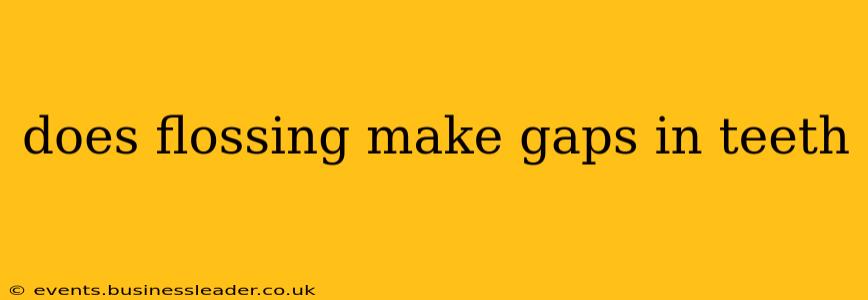Does Flossing Make Gaps in Teeth? Separating Fact from Fiction
The question of whether flossing causes gaps in teeth is a common concern, often fueled by anecdotal evidence and misconceptions. The short answer is: no, proper flossing does not create gaps between your teeth. However, several factors can contribute to the perception that flossing causes gaps, and understanding these is crucial.
This article will explore the relationship between flossing and gum health, address common misconceptions, and provide you with the information you need to maintain optimal oral hygiene.
What Causes Gaps Between Teeth (Diastemas)?
Before addressing the flossing myth, let's understand what actually causes gaps between teeth, medically known as diastema. Several factors contribute:
- Genetics: In many cases, the size and shape of your teeth and jawbone are genetically determined. If your teeth are naturally smaller than the space they occupy in your jaw, gaps can result.
- Gum Disease: Severe gum disease (periodontal disease) can lead to bone loss around the teeth. This loss of support can create the appearance of gaps, though the gap itself is a symptom of the underlying gum problem, not the cause.
- Tooth Loss: When a tooth is lost, the surrounding teeth can shift, creating gaps.
- Abnormal Frenulum: The frenulum is the small piece of tissue connecting your lip to your gum. An abnormally positioned or large frenulum can pull on your teeth, causing gaps.
- Habits: Thumb sucking or other habits that apply pressure to the teeth, particularly in childhood, can contribute to diastema.
Why the Misconception that Flossing Causes Gaps?
The idea that flossing causes gaps likely stems from a few misunderstandings:
- Existing Gum Recession: If you already have receding gums, flossing may reveal existing gaps that were previously hidden by the gum tissue. Flossing didn't cause the gap; it simply made it more visible.
- Improper Flossing Technique: Aggressive or incorrect flossing can damage your gums, leading to inflammation and bleeding. This inflammation can make your gums appear to recede, potentially revealing gaps. Gentle flossing is crucial.
- Misinterpretation of Gum Health: Healthy gums are firm and pink. If your gums bleed easily while flossing, it signals gum inflammation, requiring attention from a dentist. This bleeding is a sign of an underlying problem, not a consequence of flossing itself.
- Confusing Correlation with Causation: Someone might notice a gap appearing around the same time they started flossing. This doesn't mean flossing caused the gap. The gap might have developed gradually due to other underlying factors.
How to Properly Floss Your Teeth
Correct flossing technique is essential to avoid damaging your gums. Here are the key steps:
- Use the right amount of floss: About 18 inches is sufficient.
- Wrap the floss around your middle fingers: This leaves enough floss for each tooth.
- Gently guide the floss between your teeth: Use a back-and-forth motion to avoid snapping the floss against your gums.
- Curve the floss around each tooth: Make a "C" shape to hug the tooth.
- Gently slide the floss up and down: Clean the sides of each tooth.
- Use a clean section of floss for each tooth: Avoid spreading bacteria.
Does Flossing Help Prevent Gaps?
While flossing doesn't directly cause gaps, proper flossing is crucial for maintaining gum health. Healthy gums are essential for supporting your teeth, reducing the risk of bone loss and the subsequent appearance of gaps caused by periodontal disease.
When to See a Dentist
If you notice bleeding gums, receding gum lines, or any changes in your teeth or gums, consult a dentist immediately. Early intervention can help prevent more significant problems.
In conclusion, flossing correctly is a vital part of maintaining good oral hygiene, and it does not cause gaps in your teeth. Gaps are typically caused by other underlying factors. If you have concerns about your teeth or gums, consult a dental professional for proper diagnosis and treatment.
